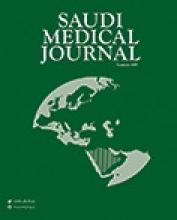Abstract
OBJECTIVE: To investigate the incidence and diagnostic features of eosinophilic esophagitis (EoE) in a group of children with dysphagia and gastroesophageal reflux disease.
METHODS: This study was designed as a retrospective case analysis of 229 patients who underwent upper gastrointestinal endoscopy between January 2009 and January 2012 at a private tertiary care hospital in Riyadh, Saudi Arabia to ascertain the proportion of patients with eosinophilic esophagitis.
RESULTS: Out of 229 children, 14 children were diagnosed as EoE (esophageal eosinophil count more than 15/high power field on esophageal biopsies), but 3 children were excluded because of other associated conditions. There were 8 males and 3 females with a mean age of 8.4 years (<18 years). The major presentation was dysphagia followed by vomiting and epigastric pain. History of allergy and bronchial asthma was present in 40-50% of children. Peripheral eosinophilia was present in 36.3% (range 7-28%). Barium contrast was abnormal in 3 children. Typical ringed (circular) appearance of esophagus was found in 3, linear furrowing in 2, and moderate to severe esophagitis in 8 children. All the patients were managed with swallowed inhaled steroids, except 2 patients who were initially given systemic steroids.
CONCLUSION: Eosinophilic esophagitis is not an uncommon manifestation in children with dysphagia, and should be considered as one of the top differential diagnoses in patients with reflux esophagitis.
- Copyright: © Saudi Medical Journal
This is an open-access article distributed under the terms of the Creative Commons Attribution-Noncommercial-Share Alike 3.0 Unported, which permits unrestricted use, distribution, and reproduction in any medium, provided the original work is properly cited.






